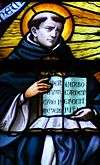Inter multiplices pastoralis officii
| Inter multiplices pastoralis officii | |
|---|---|
 | |
| Created | August 4, 1690 |
| Author(s) | Pope Alexander VIII |
| Purpose | Declared that the 1682 Declaration of the clergy of France was null and void, and invalid. |
Inter multiplices pastoralis officii (Ecclesiastical Latin: [ˈinter mulˈtiplitʃes pastoˈralis ofˈfitʃi.i]) is an apostolic constitution in the form of a papal bull promulgated by Pope Alexander VIII in 1690, and published in 1691, which quashed the entire proceedings of the 1681 Assembly of the French clergy and declared that its 1682 Declaration of the clergy of France, on the liberties of the Gallican Church and ecclesiastical authority, was null and void, and invalid.[1]
According to the Enchiridion symbolorum, Inter multiplices pastoralis officii "did not impose a theological censure on the articles."[2]
Charles Bachofen commented about 1917 Code of Canon Law canon 1323 on the material object of faith, in A commentary on the new Code of the canon law, that papal "decisions do not receive their obligatory force from the consent of the Church" as asserted in Declaration of the clergy of France article 2 "but embrace the whole extent of the object of the infallibility inherent in the teaching Church."[3] "The term 'null and void' is of course juridical rather than doctrinal. The strongly worded judgment" is written to be on a "juridical level" and affects all four articles of the Declaration of the clergy of France, according to Richard Costigan, in The consensus of the Church and papal infallibility.[4] Costigan notes that Inter multiplices pastoralis officii "does not make any particular comments" either about conciliarism or about "the consensus of the Church" addressed in the articles.[5]
Notes
Citations
- ↑ Denzinger 2012, nn. 2281–2285.
- ↑ Denzinger 2012, p. 487.
- ↑ Bachofen 1921.
- ↑ Costigan 2005, pp. 20–21.
- ↑ Costigan 2005, p. 21.
References

- Costigan, Richard F. (2005). The consensus of the church and papal infallibility : a study in the background of Vatican I. Washington, DC: The Catholic University of America Press. pp. 20–21, 106–107, 158–159. ISBN 9780813214139. JSTOR j.ctt285016.

- Denzinger, Heinrich; Hünermann, Peter; et al., eds. (2012). Enchiridion symbolorum: a compendium of creeds, definitions and declarations of the Catholic Church (43rd ed.). San Francisco: Ignatius Press. ISBN 0898707463.


Further reading
- Whiteman, Anne (2008) [1961]. "The Church and State". In Carsten, Francis L. The new Cambridge modern history. 5. Cambridge [u.a.]: Cambridge University Press. pp. 122–148. doi:10.1017/CHOL9780521045445.007. ISBN 9781139055802 – via Cambridge Histories Online.
